To help to achieve ecological recovery worldwide, more multinational corporations are making commitments to biodiversity conservation1–3. According to the most recent assessment in 2018, 31 of the 100 largest companies by revenue worldwide (the global Fortune 100) have done so, from the retail corporation Walmart to the insurance company AXA4.
To deliver real gains — in the population sizes of endangered species, say, or in the number of hectares of restored forests, grasslands or wetlands — large organizations need to determine which of their activities have the greatest impacts on biodiversity5. And they need to disclose and mitigate those impacts. Currently, methods for doing this are lacking (see ‘Promises are hard to keep’). (By large organizations, we mean formal entities composed of hundreds of people or more that act towards a certain purpose, whether in the public, private or non-profit sectors.)
When quantitative analyses have been done, a variety of metrics have been used to quantify impacts. These range from the proportion of local species that would be lost as a result of an activity, to factors such as hectares of habitat affected, or the amount of sustainably sourced paper, fish or palm oil that is used4. But the choice of metric can radically alter the results of an impact assessment, so it is difficult to compare organizations. Likewise, few analyses consider the impacts of activities that are not under the direct control of the organization, such as those associated with supply chains6.
Lessons from first campus carbon-pricing scheme
As a proof of principle, we conducted a comprehensive assessment of biodiversity losses associated with activities at the University of Oxford, UK. We used data on purchasing, travel bookings, utility bills and other information from the 2018–19 and 2019–20 academic years. The 60 activities we assessed included the day-to-day running of buildings and transport services; travel (including flights) for students and researchers; construction of laboratories and other buildings; consumption of food and beverages at restaurants and cafeterias; and use of medical supplies and other materials in research labs.
Our aim was to demonstrate what it would take for a large organization such as the University of Oxford to bring about a net gain in biodiversity — meaning that, thanks to its actions, the world’s biodiversity is left in a better state than it was before. As part of our analysis, we assessed how the university’s various activities and operations also affect greenhouse-gas emissions, and how those, in turn, affect biodiversity by driving climate change.
We are confident that the approach we’ve developed for Oxford could be applied more broadly. Indeed, we hope that such a well-known institution disclosing a full assessment of its biodiversity footprint will offer powerful inspiration for others. (All seven of us have a current or previous affiliation with the university.)
What we did
The University of Oxford launched an ambitious environmental sustainability strategy in March 2021. Its two main goals are to achieve biodiversity net gain and net-zero carbon, both by 2035. (The latter means that the university will remove as much carbon from the atmosphere as it adds.)
To understand how challenging these goals might be to fulfil, we assessed the environmental impacts of the university’s various activities. This covered all those to do with research, education and operations during an academic year for staff and students (see ‘Upstream effects’). For our purposes, operations includes the university transport fleet, consumption of departmental food and utilities, waste disposal and the operational supply chain, including for paper.
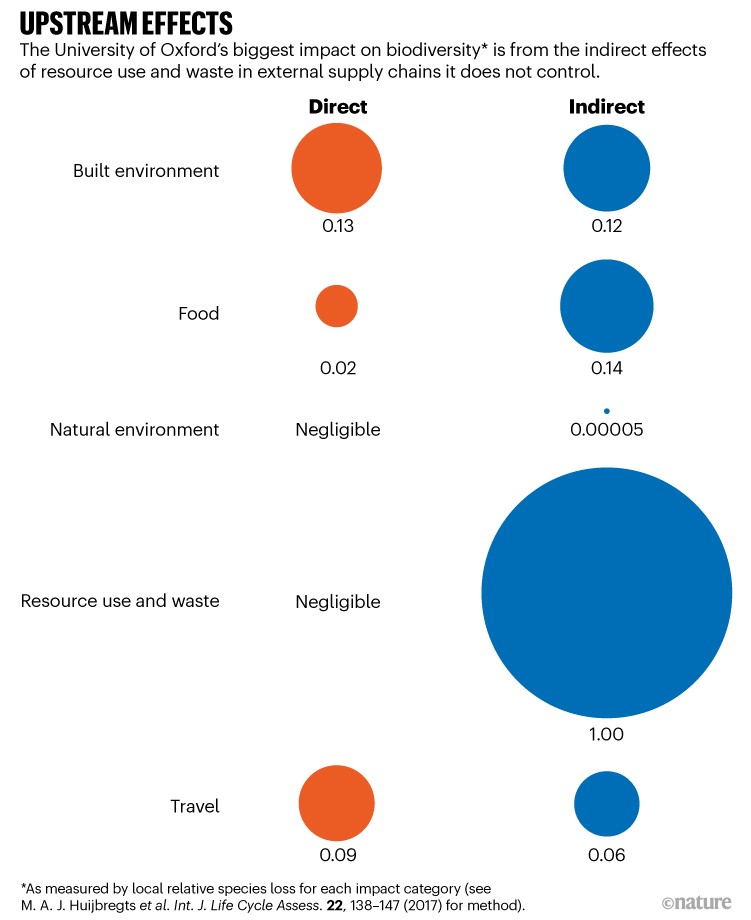
Source: J. W. Bull et al.
As a first step, we defined a conceptual framework to systematically categorize the environmental impacts. We grouped activities in research, education and operations according to whether they involved any of five features: travel; food; the built environment (university buildings); the natural environment (any green space or land owned by the university, including managed parks and gardens); and resource use and waste (see ‘What we left out’). Each of these is associated with five general environmental impacts: greenhouse-gas emissions, the use of land and water, and pollution of water and air.
To further categorize the environmental impacts, we assigned each activity to one of two groups: those under direct university control or influence (through staff and key contractors), and those that the university can influence only indirectly (through students and supply chains). We deemed students buying tuna sandwiches from a university-owned cafe as direct control, for instance, because the university could decide to serve only vegetarian food. However, it can influence only indirectly what happens up the supply chain, before materials are used in a research lab, for example.
Using this organizational framework, we worked with administrators to obtain the relevant information, such as travel bookings for staff and students, electricity and water bills, and purchasing records for goods, services and materials used in construction projects.
Next, we used various tools to convert all the activities data into estimates of ‘mid-point environmental impacts’ (amount of carbon dioxide emitted, land or water used, and air or water pollutants produced). The database Exiobase 3 is one of the most extensive sources of international supply-chain impacts worldwide7. It shows, for instance, that the roughly US$3.5 million the university spent on paper and paper products in 2019–20 contributed to atmospheric acidification by releasing 2,448 kilograms of sulfur dioxide equivalent. Similarly, the UK Higher Education Supply Chain Emissions Tool uses spending data on goods and services to estimate greenhouse-gas emissions. The roughly $23 million Oxford spent on personal computers, printers and calculators in 2019–20, for example, produced an estimated 20,105 tonnes of CO2 equivalent.
We then needed to estimate the extent of biodiversity loss associated with this wide range of broad environmental impacts. So we converted the mid-point environmental impacts into ‘end-point impacts’ that are specifically concerned with biodiversity. To do this, we used an established conversion methodology called ReCiPe8. The output metric ultimately linked to each activity is based on the proportion of local species that would be lost as a result of that activity, relative to the number that exists currently (see Supplementary information for all results and conversion factors).
Caveats
We refined our methods slightly when analysing data from the 2019–20 academic year. This, combined with the disruption caused by the COVID-19 pandemic, makes it difficult to compare years. So for simplicity, we report our results only from the 2019–20 academic year.
Biodiversity: The ravages of guns, nets and bulldozers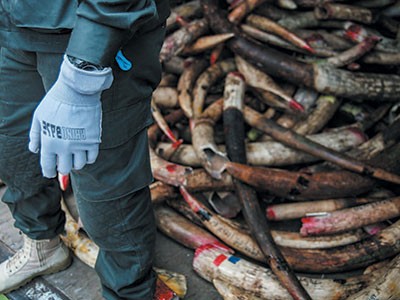
The biodiversity metric we obtain using ReCiPe is based on strong evidence: the conversion tool is derived from the results of hundreds of studies of the impacts of human pressures on biodiversity8. But, in general, we weren’t able to factor in fine-level variables, such as whether the beef steaks in a university-owned restaurant are sourced from a UK or Brazilian farm. As such, our approach is best seen as a way to evaluate relative impacts, rather than as an indicator of precise absolute impacts.
This difficulty aside, it is hard to compare the impact of the University of Oxford on biodiversity with that of similarly sized organizations. As yet, and as far as we know, no other organization has comprehensively evaluated and disclosed its impact on biodiversity, and then had its assessment independently validated. (Ecologists and other stakeholders at the University of Jyväskylä in Finland have begun to explore the impacts of that university’s activities on biodiversity using a similar approach to ours.)
Using the greenhouse-gas metric, however, we can compare the impacts of the University of Oxford on emissions (which are related to its impacts on biodiversity) with those of comparably sized organizations.
What we found
The absolute size of the university’s greenhouse-gas footprint is astonishingly large — comparable to that of the eastern Caribbean island nation of Saint Lucia. It is two orders of magnitude smaller than Microsoft’s greenhouse-gas footprint, but one order of magnitude larger than that of the London Stock Exchange, according to estimates publicly disclosed by those organizations.
Perhaps the most striking finding in our assessment of impacts specifically on biodiversity is that most of the harms are tied to university activities that are not under its direct control. In fact, the activities with the five biggest impacts on biodiversity are (from biggest to smallest): the supply chain for research activities (such as for chemicals, medical products, organic tissue and plastics); the supply chain for the day-to-day running of buildings (for paper, information technology and so on); food consumption; electricity consumption; and the supply chain for construction. All of these activities are associated with resource use and waste, food and the built environment.
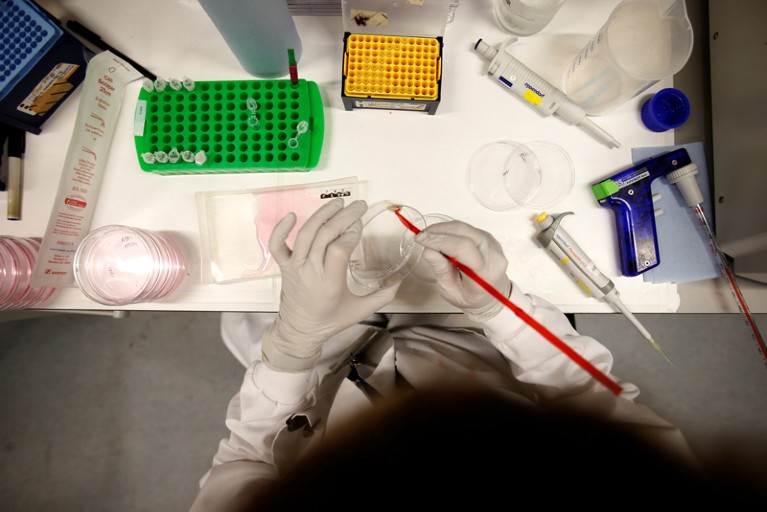
The University of Oxford’s use of laboratory materials has a large impact on biodiversity because of the upstream supply chain.Credit: Peter Nicholls/Reuters
In short, supplies of lab equipment have much greater impacts on biodiversity overall than do international flights, the university’s consumption of electricity or its use of construction materials. (Personal protective equipment used in the lab, for example, requires the extraction and industrial processing of hydrocarbons, often from areas that are rich in biodiversity.)
This observation is in line with the results of a handful of studies that suggest that supply chains, not transport or the day-to-day running of buildings, are the main contributors to greenhouse-gas emissions for universities (see, for example, ref. 9). It also aligns with the results of assessments by the fashion giant Kering since 2012, using its Environmental Profit & Loss account — a tool designed to quantify the environmental impacts of the company’s activities. These have revealed that Kering’s procurements of commodities, such as leather, wool and metals, have much more impact on greenhouse-gas emissions, particularly on those from land use, than does the day-to-day running of its factories and offices10.
Yet the sustainability strategies of large organizations typically focus not on supply chains, but on recycling, reducing the number of flights people take or the amount of electricity used11–13 (see also Nature 546, 565–567; 2017).
Another important finding is the scale of intervention needed. Restoring the university’s owned land (around 1,000 hectares) to native woodland or some other natural habitat would make little difference when it comes to compensating for the impacts on biodiversity that result from just one year of activity. The university colleges own much more land than the university itself — some 50,000 hectares — but we excluded them from our analysis because they are independent legal entities that manage sustainability issues separately.
Biodiversity boost
How could the university reverse the biodiversity losses stemming from its activities and operations?
Here we consider three options. It could pursue its current environmental sustainability strategy. This entails (among other steps) setting quantitative targets to reduce flights, limiting consumption of all single-use products, making university-catered food vegetarian by default, and achieving 20% net gain for biodiversity in new construction projects. Alternatively, it could focus more heavily on preventing harms to biodiversity. We model a scenario in which all staff flights are prevented, all use of paper and any further construction is stopped, and the purchasing of lab materials is halved. Or the university could focus on compensating for the impacts that its activities and operations have on the planet, by taking steps to increase biodiversity in other places (see ‘Oxford’s options’).
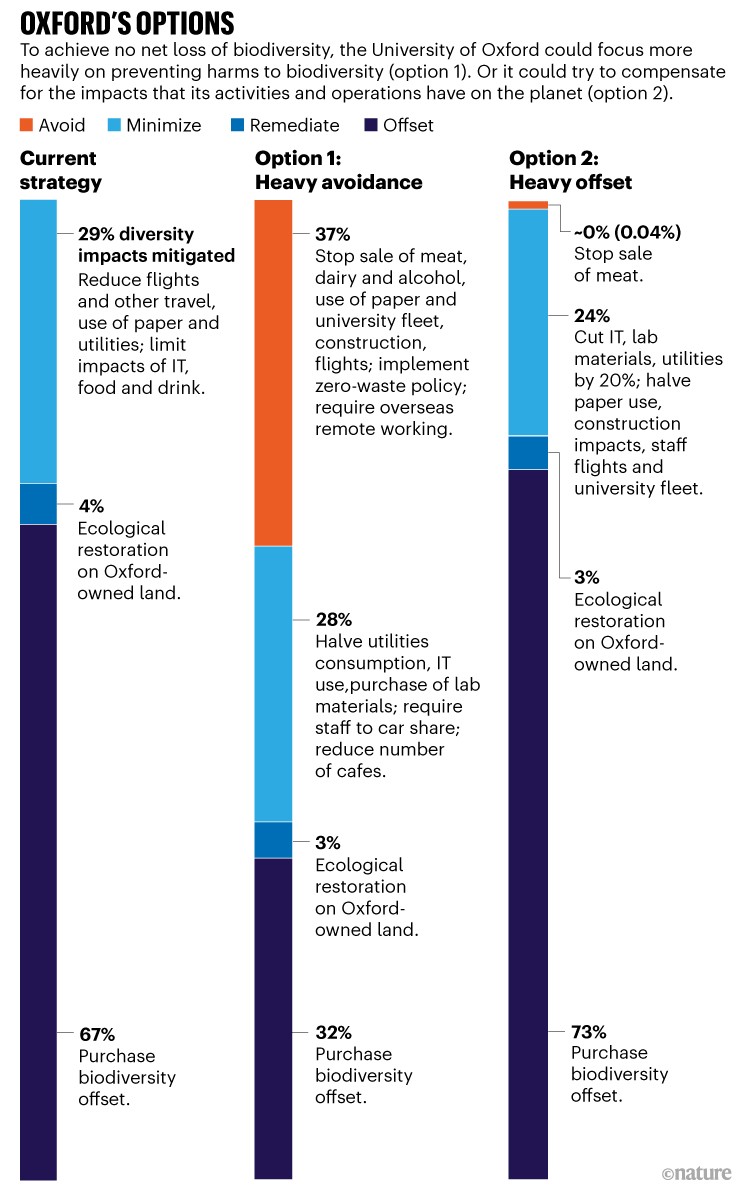
Source: J. W. Bull et al.
Using the 2018–19 academic year results (selected because the COVID-19 pandemic made 2019–20 so unusual), we estimated how far these mitigation strategies might take the university towards biodiversity net gain.
Our analysis indicates that the set of preventive measures proposed under the university’s environmental sustainability strategy get it about one-third of the way towards net gain. The findings also indicate that focusing mainly on the prevention of impacts is operationally unfeasible. Activities that have most effect on biodiversity, such as purchasing lab consumables, are central to the university’s existence and cannot simply stop.
To achieve net gain, preventive measures, such as reducing flights and paper use, will have to be accompanied by additional and extensive actions to compensate for the remaining impacts on biodiversity.
Industrial research: Drug companies must adopt green chemistry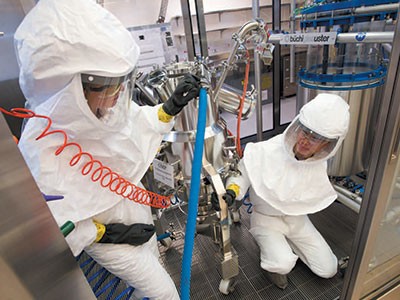
Such actions could include investing in reforestation, wetland restoration, sustainable land-management programmes and prevention of habitat loss caused by independent parties. For example, those directing the Oyu Tolgoi mining project in Mongolia are seeking to achieve biodiversity net gain by spending around 0.6% of the total project cost on actions that benefit biodiversity, such as sustainable grazing practices (see go.nature.com/3tkkbjh). Similarly, the Ambatovy metals mine in Madagascar is on course to offset its impacts on biodiverse eastern rainforests by preventing deforestation of those same habitats through small-scale agriculture14.
Achieving true biodiversity net gain will require substantial offsetting that does not necessarily contribute to the university’s reductions in greenhouse-gas emissions. But whatever mix of approaches the institution pursues, it should strive for win–wins on both biodiversity and climate.
Many types of action can simultaneously increase biodiversity and reduce greenhouse-gas emissions. For example, restoring mangroves in Bangladesh increased populations of wintering water birds 20-fold in just three years from 2004. And these restored mangroves can absorb carbon four times faster than land-based forests can15. But in other cases, there are trade-offs. Constructing wind turbines and solar photovoltaics to produce renewable energy, for instance, requires extensive mining of metals in places that can be rich in biodiversity16.
Net gain for other organizations
Our calculations are likely to be comparable to results for other universities. In our analysis, we do not include the impacts of individual colleges. But because similar kinds of activity occur in colleges as in the rest of the university, their inclusion — or of halls of residence at other universities — is unlikely to qualitatively change our main findings. In fact, because of the colleges’ unusually large land holdings, including them would arguably result in an assessment that doesn’t so easily compare with those of other universities.
Crucially, however, the analytical framework we have developed can be applied to a wide range of large organizations — whether they be universities, multinational corporations or government institutions.
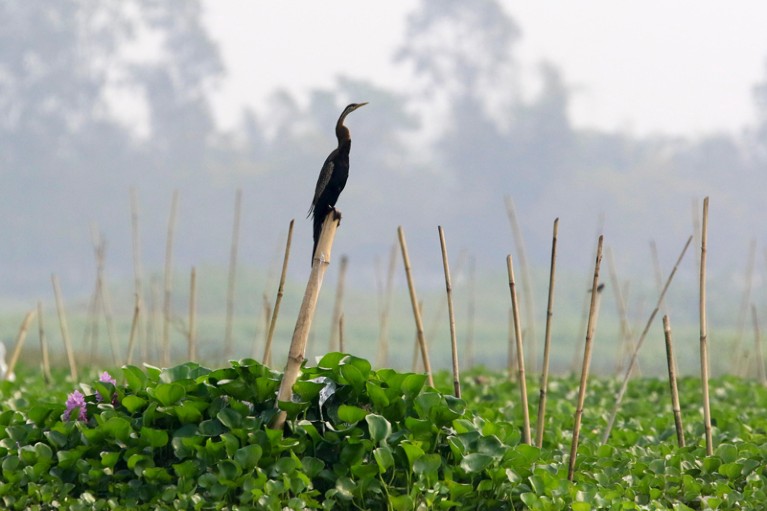
Restoring mangroves in western Bangladesh increased populations of wintering water birds, such as this oriental darter (Anhinga melanogaster).Credit: Muhammad Mostafigur Rahman/Alamy
Governments, intergovernmental organizations and multinational corporations are increasingly recognizing that it will not be enough to simply slow the loss of the world’s biodiversity. Damaged habitats and depleted natural resources must be restored to prevent the collapse of ecosystems.
Last year, the United Nations called for the urgent revival of nature in farmlands, forests and other ecosystems, declaring 2021–30 to be the Decade on Ecosystem Restoration. Later this year, at a meeting in Kunming, China, it is hoped that 196 nations will agree to the Post-2020 Global Biodiversity Framework of the Convention on Biological Diversity. Among the goals listed in the draft document are a “net gain in the area, connectivity and integrity of natural systems of at least 5 per cent”17.
We urge all large organizations, academic or otherwise, to commit to strategies for a net gain in biodiversity — and to adopt formalized approaches that quantify current impacts and allow transparent tracking of progress. Otherwise, the degree of worldwide recovery of natural resources increasingly recognized as crucial for resilient societies to function will not happen.
A key challenge is the lack of traceability for commodities. Both our assessment of the University of Oxford and those of others have revealed that large organizations often don’t know which country their commodities (such as cotton, flour or cement) come from — let alone which supplier or what kinds of biodiversity are being affected as a result.
According to its 2022 report, for example, even a sector leader such as Kering could trace the source of only about three-quarters of its cotton. Supply chains for other commodities, such as sand, are even more opaque18.
Encouragingly, various initiatives are being developed to provide more transparency about environmental impacts across supply chains. These include the supply-chain mapping tool TRASE, which aims to address deforestation.
A related challenge, covered extensively elsewhere19,20, is how to ensure that biodiversity offsets are effectively and appropriately implemented such that they lead to conservation outcomes that are truly additional.
Currently, there are uncertainties around how long it takes for a restored forest to start delivering biodiversity gains, whether promises to offset harms to biodiversity are actually met, what level of biodiversity gain is delivered by the restoration of a particular habitat, and so on. Take the Ambatovy mine in Madagascar. Its directors began protecting areas of eastern rainforest in 2009 to offset the impacts of deforestation directly caused by the mine. Yet forest gains are not estimated to balance losses until sometime between 2018 and 203314.
Despite such challenges, however, we think that a commitment to full transparency, and to improving data collection over time, will enable organizations to compare performance and drive change — both in their own operations and throughout supply chains.
Time is too short to let the perfect be the enemy of the good, or to claim that biodiversity net gain is too hard to achieve because there is no universal biodiversity metric. Individual metrics are imperfect but improving, and their limitations should not be a reason to delay measuring, disclosing and tackling impacts on biodiversity.


 Lessons from first campus carbon-pricing scheme
Lessons from first campus carbon-pricing scheme
 Industrial research: Drug companies must adopt green chemistry
Industrial research: Drug companies must adopt green chemistry
 Biodiversity: The ravages of guns, nets and bulldozers
Biodiversity: The ravages of guns, nets and bulldozers





